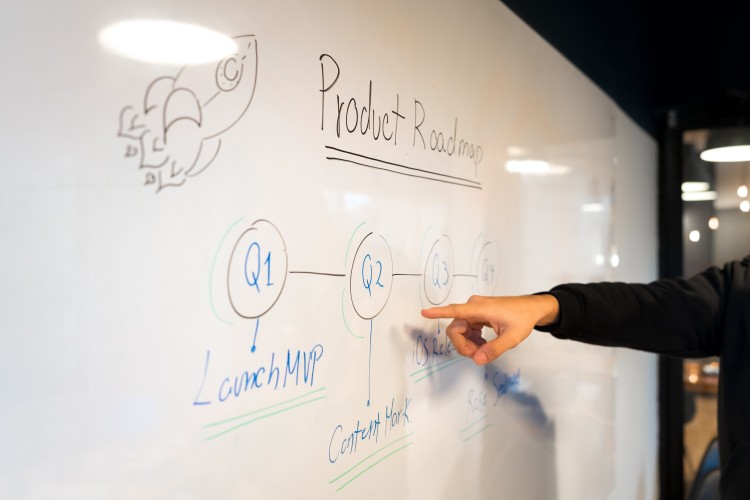
It’s easy to forget how departments rely on each other — especially in the world of hybrid or remote working. There’s an assumption that the work of one department has little effect on the work of another department, but that simply isn’t true.
Think of it like this: departments can be a lot like dominos. The piece before has to fall before the next department gets to work. For example, the product team needs to achieve a certain checkpoint before marketing can get to work.
This means that there are often a lot of questions being thrown at the product team. “When can marketing get started on the launch campaign?”, “When will users receive the big feature update they’re asking for?”
Pushing crucial updates to a large group of people can be tough, especially when they all have different questions and needs.
This is where a now, next, later roadmap comes in.
Now, next, later roadmap: a definition
The now, next, later roadmap helps teams to clearly communicate priorities and timeframes.
It’s perfectly suited to fast-paced environments with ever-changing priorities, like businesses that use agile methodologies. Teams can quickly and easily keep stakeholders in the loop with any roadmap fluctuation by using now, next, later roadmaps.
Like most other roadmaps, the now, next, later roadmap is a strategic tool that offers a clear overall vision of the product. It should offer a holistic view of the project objectives and the customer needs the product should solve. The roadmap will also give a general direction for the team to follow by splitting work into manageable and logical iterations.
It’s important to note that the now, next, later roadmap is not a finalized plan — or even a concrete statement of intent. It’s a tool to be used by businesses that understand how plans can change at the drop of a hat and teams that have the flexibility to pivot at the last second. It is there to remind you of the product and business vision. It’s simply a view to the bigger picture, with wiggle room to handle any changing requirements.
How to use the now, next, later roadmap framework
As the now, next, later roadmap avoids fixed specifics, it can be used for a wide range of activities from product development to a complete project transformation.
When to use the now, next, later roadmap template
Now, next, later roadmaps are fantastic for new businesses or products that are still finding their feet. They enable clear communication of broad plans without committing to specific details or deadlines. This is critical in the early stages of development, be it the development of a product or a business.
The roadmap is also well suited for communicating with large audiences, as it offers a simple, streamlined look at the road ahead in a way that anyone can understand. If you wanted to keep your loyal user base updated with where you are at in the launch of a new product, the now, next, later roadmap gives them enough information to peek behind the curtain.

When not to use the now, next, later roadmap template
Now, next, later roadmaps are less suited to a team that already knows what they’re doing. Communication within the product organization should be a little more specific, much in the way a sprint planning roadmap would be.
They’re also a less useful tool to use when communicating with executives or other audiences that require detail, such as a stakeholder group. To offer a clear but detailed communication channel to these audiences, you would be much better off using an objective timeline roadmap.
Learn more about stakeholder management in our dedicated guide here.
Stages of the now, next, later roadmap explained
The beauty of the now, next, later roadmap is in its simplicity. But for the sake of avoiding any doubt, let’s break down each stage of this roadmap template in more detail.
Understanding “Now”
The “Now” stage focuses on what is being worked on already. This first stage can be both practical and executional, depending on the needs of the team. It allows teams to easily track high-level issues and focus on specific features that are currently being worked on.
Say you’ve just come up with an idea for an app, your first steps — the “now” — would be to go out to the market and seek proof of concept and market validation. If you’ve already validated the concept, the thing to do ‘now’ might be to start developing wireframes. If you’ve already got the wireframes, the thing to do ‘now’ might be to test those wireframes with users. And so on.
Understanding “next”
Next up is the “next” stage, which focuses on what’s to come. What’s on the schedule for the next few months? What do we hope to achieve? What’s the next stage in the development cycle?
This is the stage where you start communicating priorities to your team and stakeholders. It’s also where the now, next, later framework starts to shine, as it offers a clear and useful level of segmentation. This does however mean your “next” stage could look completely different compared to your “now” stage, but don’t worry about that. While it may look strange, it is all covered by the same framework, which means all the stages will naturally flow into each other.
When it comes to developing apps, this “next” stage could outline principles for going to market or display the role of the sales team when it comes to the product launch.
Understanding “Later”
If that “next” phase is starting to look a little bloated, then you’ll be pleased to learn about the “later” part of the now, next, later roadmap.
We know how tempting it can be to bundle every single task into the “next” stage, even if those tasks aren’t essential. This is where the “later” stage comes into play. This stage is for tasks that are in the product backlog that aren’t urgent or crucial to the product but may offer further value if pursued.
During this stage, you can visualize any aspirations for the product and look ahead to how the product may evolve over time. So for an app, this may include future feature updates or UX overhauls.
Building a now, next, later roadmap
Simple ideas come with simple executions, and your now, next, later roadmap doesn’t need to be any more complicated than a Kanban-style board like the now, next, later example shown below.
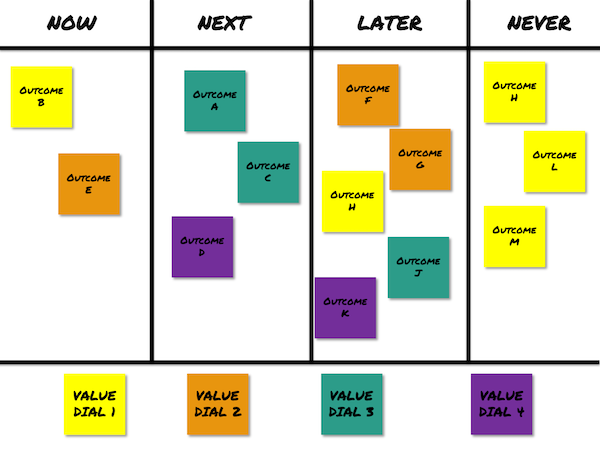
Of course, if you do have access to roadmap software or a higher-fidelity and interactive version of your now, next, later template then that’s even better.
In airfocus, you can build a now, next, later roadmap like this:
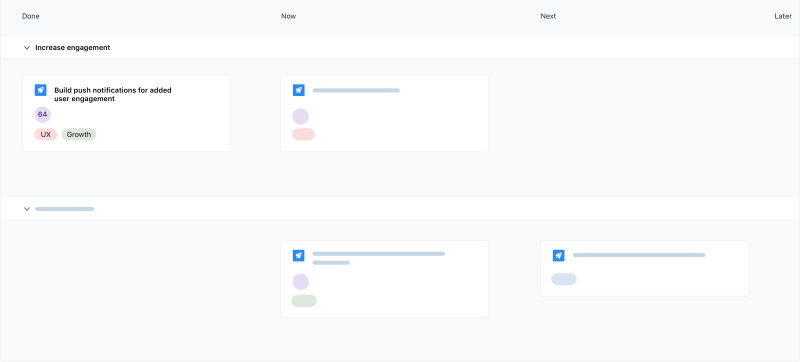
You can then share the roadmap with tailored views for different audience types, as well as assign tasks to different colleagues to get a real-time update of how everyone is doing against their goals.
Benefits of using a now, next, later roadmap
With all the how of now, next, later roadmaps straightened out, let’s dive into the whys. What are the benefits of using the now, now, later roadmap and what kinds of businesses will benefit the most?
Now, next, later roadmaps are fantastic tools for budding upstarts that are rapidly changing as they find their place in the market. They’re a streamlined and simplistic way of communicating key information during the early stages of product development. Crucially, they communicate broad plans without committing to specific deadlines that may hamper the development team’s efforts.
Now, next, later aligns teams by providing clarity in the present. Work can be broken down into manageable, realistic steps which stop the team from feeling overwhelmed by the overall workload. Teams can gain a better understanding of what is going on and in which order tasks should be completed to best serve the product. These bite-sized chunks also help the team to stay focused on customer needs and experiment with potential features or objectives while also facilitating the discussion of broad plans without feeling like they’re taking on too much.
With now, next, later, the product team can easily reassess their current strategy and reprioritize without needing to rewrite the entire roadmap. Teams will be able to quickly and easily pivot to better suit the product vision and changing requirements. This is incredibly helpful for Agile teams which need to do this on a regular basis.
This framework also allows teams to focus on time frames rather than specific deadline dates. It’s not a tool for granular details, but rather a way to focus on broad plans across a wider range of time.
Better still, the now, next, later roadmap template avoids tying activities to set dates while still helping teams plan into the future. Rather than struggling to get everything right on the first attempt, you can use now, next, later to communicate adjustments over the course of weeks, months, and even years.
We mentioned before how flexible and adaptable the now, next, later roadmap is and we meant it. The above are just a handful of the benefits of using this roadmap template, and while startups and new businesses can arguably benefit most, anyone or any team could use the framework to get a better handle on any new product, project, or business plan.

What’s the deal with now, next, later and OKRs?
Despite its simplicity, the now, next, later template has a surprisingly useful application when it comes to outlining and helping a team achieve its OKRs.
Objectives and Key Results (OKRS) are set at the beginning of a quarter as a way of offering your team a sense of direction for the coming months. Your objectives represent your North Star Metric (NSM) your key results will help your team measure their progress, and your projects are how you will move the needle.
From there, you should be measuring your OKR progress on a week-to-week basis to see if the work you’re doing is having a positive impact or not. Everything looks good? Brilliant, keep up the good work. Things are starting to get off track? It might be time to reassess the roadmap.
It’s incredibly easy to reassess a now, next, later roadmap as you can quickly move things around without causing too much trouble. Remember, the “now” stage shouldn’t need to change as that represents the work that is being performed in the present, but the next and later stages are fair game. This offers far more flexibility than a traditional timeline ever could as we’re now thinking in value rather than capacity.
Click here to learn more about setting OKRs for product management.
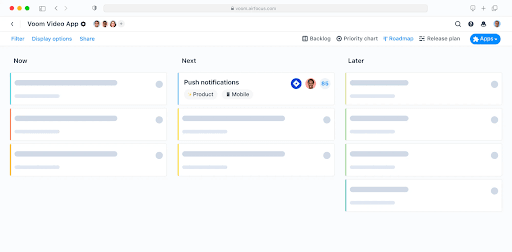
Now, next, later roadmap examples
Let’s look at some examples that demonstrate how the now, next, later roadmap can be applied to product development, marketing, and even your personal life.
Product Development:
Now: Conduct market research to identify potential customer needs and pain points.
Next: Develop a minimum viable product (MVP) to test in the market and gather feedback.
Later: Iterate on the MVP based on feedback and prepare for a full product launch.
Within the product development space, you can use the now, next, later roadmap to further breakdown actions listed in the big picture roadmap.
So for the MVP development, we could break the process down like this:
Now: Develop and launch the first iteration of the MVP.
Next: Add more user-requested features.
Later: Re-imagine some of the product's core offerings.
A now, next, later roadmap for user onboarding would look something like this
Now: Implement a basic user authentication system.
Next: Develop user profile creation and editing functionality.
Later: Integrate third-party API for additional features.
For something like security features for a SaaS platform, your now, next, later roadmap would look a little more complex, like this: Now: Implement secure user authentication and access control to ensure only authorized users can access the system and its data.
Next: Implement continuous monitoring and logging to detect and respond to security incidents in real-time.
Later: Conduct regular security audits to identify vulnerabilities and ensure compliance with relevant security standards and regulations.
Marketing Strategy:
The now, next, later roadmap works well for multi-phase marketing strategies. For example, an early-stage marketing strategy for a start-up could look like this: Now: Launch social media campaign to increase brand awareness.
Next: Create a referral program to incentivize existing customers to bring in new business.
Later: Develop a content marketing strategy to establish thought leadership and attract organic traffic.
Personal Goals:
Now, next, later roadmaps are another product management tool that can translate to our everyday lives. Say you’re looking to increase your wellness, try something like this:
Now: Commit to a regular exercise routine of at least 30 minutes daily.
Next: Cut out processed foods and focus on a balanced diet of whole, nutrient-dense foods.
Later: Enroll in a yoga or meditation class to incorporate mindfulness practices into your daily routine.

Now, next, later template
Rather than drawing up a now, next, later every time you need to use the roadmap, you can use airfocus’ outcome based roadmap template.
The outcome based roadmap focuses on the overall business-critical goals and objectives of product development, rather than features or sprints. It’s an extremely flexible tool that helps teams better communicate, collaborate and align with stakeholders on the what and the why of product development.
As the now, next, later roadmap is itself an outcome based roadmap, outcome based roadmaps incorporate now, next, later as well as other tools.
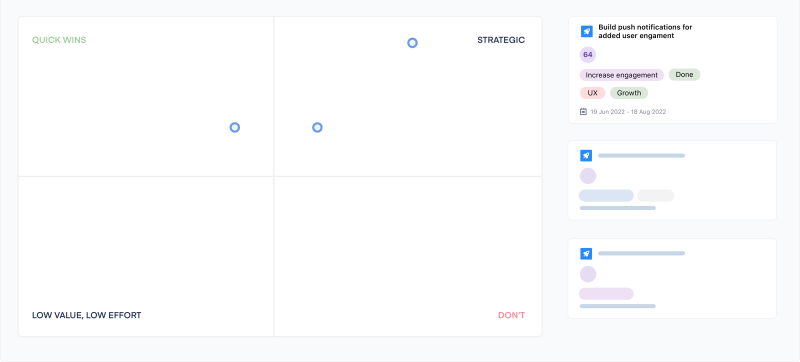
Roadmapping from A to Z
Want to learn everything there is to know about roadmapping? Take a look at our free ebook “Roadmapping From A to Z”, featuring over 60 pages of information on roadmapping with a focus on product roadmaps.
Looking to dive straight in? Check out our great range of roadmap templates to help you get started quickly and easily.
Whatever you need, airfocus is here to help.

Tomas Prochazka

Read also




Build great roadmaps

Experience the new way of doing product management




